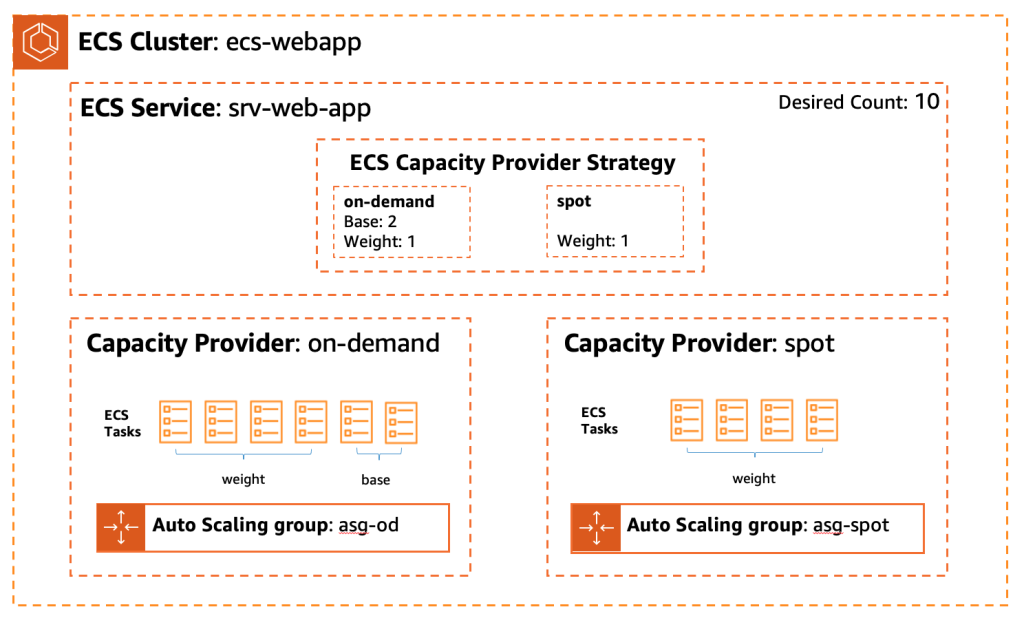Containers
Category: Amazon EC2 Container Service
Automate rollbacks for Amazon ECS rolling deployments with CloudWatch alarms
Introduction Amazon ECS now offers native support for monitoring and automatically reacting to changes during a rolling update by using Amazon CloudWatch metric alarms. This enables customers to easily automate discovery and remediation for failed deployments and minimize the performance and availability impacts. Customers can configure Amazon CloudWatch alarms for their rolling updates using the […]
Optimize cost for container workloads with ECS capacity providers and EC2 Spot Instances
Amazon EC2 Spot Instances use spare Amazon Elastic Compute Cloud (Amazon EC2) capacity at up to a 90% discount compared to On-Demand prices. Amazon EC2 can interrupt Spot Instances with a two-minute notification when EC2 needs the capacity back. Spot Instances are an ideal option for applications that are stateless, fault-tolerant, scalable, and flexible, such as big data, […]
Three things to consider when implementing Mutual TLS with AWS App Mesh
Mutual Transport Layer Security (mTLS) is an extension of TLS, where both the client and server leverage X.509 digital certificates to authenticate each other before starting communications. Both parties present certificates to each other and validate the other’s certificate. The key difference from any usual TLS communication is that when using mutual TLS, each client must […]
New look for Amazon ECS in the AWS Management Console
Recently we launched a new look and experience for Amazon ECS in the AWS Management Console. Since its launch in 2014, Amazon Elastic Container Service (Amazon ECS) has served as a simple way for customers to run production grade container workloads on AWS. Customers such as Disney+, Vanguard, Okta, Fidelity, and UbiSoft trust Amazon ECS […]
Using Windows Authentication with Linux Containers on Amazon ECS
This post shows how to configure a Linux container running on Amazon Elastic Container Service (Amazon ECS) to connect to a SQL Server database using Windows (or Integrated) Authentication. Windows Authentication is the recommended mechanism to connect to SQL Server databases, but using it can be challenging when running containerized workloads.
Results of the 2020 AWS Container Security Survey
In 2019 we carried out the first AWS Container Security Survey and now we have the results of this year’s survey for you available. As in 2019, we conducted an anonymous survey throughout 2020 amongst container users on AWS. From the 655 people who visited the survey, 295 started it and 156 completed it (completion […]
re:Invent 2020: AWS Containers Track
re:Invent is a free, 3-week virtual conference that will be held November 30 – December 18, 2020. Starting this week, registered attendees can access scheduled and on-demand sessions on topics across AWS Services. In this post, we’ll cover the Containers track, featuring sessions on Amazon ECS, Amazon EKS, AWS Fargate, Amazon ECR, and AWS App […]
Using Amazon FSx for Windows File Server as persistent storage on Windows Containers
This post has been updated due a recent launch. Designed for simplicity from the start, Amazon ECS delivers an AWS-opinionated solution for running containers at scale. Previously, customers had to implement a lengthy workaround (detailed in the original blog post below) in order to use an Amazon FSx for Windows File Server as persistent storage […]
Designing a secure container image registry
As organizations move to containers, there can be a sense that they are losing control or visibility of the software that is deployed to their environments. Historically, once a server is in production, a scanning tool runs on a regular basis to detect vulnerabilities on the operating system. Once a vulnerability is detected, an operations […]
Using Amazon FSx for Windows File Server on EKS Windows Containers
This blog post is deprecated and the solution is no longer valid. Please refer to the new solution that uses CSI Driver posted in the following blog post: Using SMB CSI Driver on Amazon EKS Windows nodes. Recently, we published a blog post on using Amazon FSx for Windows File Server as persistent storage for […]







